Did you know that only 4% of the world’s land is used for growing food in cities? Yet, over half of the world’s people live in cities. Vertical gardening is a great way to use space well and grow lots of food, even in small city spots. It’s perfect for both experienced gardeners and beginners.
There are many nutrient-rich crops that do well in small-space vertical gardens. We’ll look at the top 10 vegetables that are great for vertical gardens. We’ll also talk about the best support structures to help your garden grow well.
Key Takeaways
- Pole beans, climbing peas, and vining tomatoes are excellent choices for vertical gardening.
- Cucumbers, zucchini, melons, and squash can also thrive when grown vertically.
- Bamboo trellises, upcycled materials, and creative support structures are versatile options for vertical gardens.
- Vertical gardening improves air circulation and makes harvesting easier.
- Careful selection of space-saving vertical garden veggies can maximize your growing potential.
Introduction to Vertical Gardening
Vertical gardening is a new way to use your space well. It lets you grow many crops in a small area. You can use trellises, cages, and nets to make even tiny spots into gardens. This method makes your outdoor space look better and helps your plants grow healthier and more productive.
Space Efficiency: How Vertical Gardens Maximize Growing Areas
Vertical gardening is great for making the most of your space. It lets you grow more plants in a small area. This is perfect for city folks, those with little backyard space, or apartment dwellers with balconies or patios. You can grow a variety of vegetables, herbs, and fruits in a small area.
Benefits of Improved Air Circulation and Easy Harvesting
Vertical gardening also has other big advantages. It keeps air moving around your plants, which helps prevent pests and diseases. This keeps your plants healthy and strong. Plus, you can pick your plants easily since they’re at eye level. Vertical gardening changes how you grow and enjoy fresh food, even in small spaces.
Tomatoes: A Classic Choice for Vertical Growing
Tomatoes are a top pick for vertical gardens. They do well on trellises, cages, or other tall supports. This lets them grow tall and produce lots of tasty fruits all season.
Choosing the right tomato types is key for vertical gardens. Indeterminate tomatoes keep growing and producing all season. They can get up to 25 feet tall, perfect for saving space in gardens. Growing them up high also keeps them away from disease and makes them easier to pick.
For vertical gardens, pick indeterminate heirloom or hybrid tomatoes that grow well upright. Great choices include Brandywine, Cherokee Purple, and Sungold. Always check the seed packet or plant label to pick the best type for your garden.
Vertical gardening uses less space than traditional gardens, great for small gardens. It lets you grow more tomatoes in less space. Enjoy a big harvest of fresh, delicious tomatoes all summer.
Cucumbers: Climbing Vines for Fresh and Crunchy Cucumbers
Cucumbers are perfect for vertical gardens because they grow up and use space well. Growing them vertically means you get fresh, crisp cucumbers all summer. Great varieties for vertical gardens include ‘Burpee Hybrid II,’ ‘County Fair 83,’ ‘Dasher 11,’ and ‘Saladin.’
Cucumber Varieties Ideal for Vertical Gardens
For cucumbers for vertical growing, some varieties are better than others. ‘Burpee Hybrid II’ is a top pick for its high yield and resistance to disease. ‘County Fair 83’ gives you long, crunchy cucumbers. ‘Dasher 11’ is dependable and grows well in many conditions. ‘Saladin’ is sweet and produces a lot.
Training and Supporting Cucumber Vines
To help your cucumber vines grow vertically, you need the right support. Use a strong trellis or cage for them to climb on. Guide the tendrils to the support, and they’ll wrap around it. This saves space and keeps cucumbers clean and straight.
| Cucumber Variety | Fruit Size | Days to Harvest | Flavor Profile |
|---|---|---|---|
| Burpee Hybrid II | 6-8 inches | 55-65 days | Crisp and refreshing |
| County Fair 83 | 8-10 inches | 60-70 days | Crunchy and sweet |
| Dasher 11 | 7-9 inches | 50-60 days | Mild and refreshing |
| Saladin | 6-8 inches | 55-65 days | Deliciously sweet |
Cucumbers are great for vertical gardens, offering a lot of fresh, crunchy produce. By picking the right cucumber varieties for vertical growing and supporting them, you can have a steady supply of these tasty vegetables all season.
Beans: Versatile Climbers for Your Vertical Garden
Beans are a great choice for a thriving vertical garden. They are climbers that can give you a lot of food while using little space. ‘Romano Italian’, ‘Meraviglia Venezia’, and ‘Gold of Bacau’ are great for growing up high.
Beans are amazing because they can give you a lot of food. Pole beans can give you two to three times more than bush beans in the same space. This makes them a smart choice for getting the most out of your vertical garden.
Beans also make your garden healthier and easier to take care of. They climb up trellises, which helps stop weeds from growing. This means you spend less time weeding. Plus, they get more sunlight, which helps them grow strong and healthy.
| Bean Variety | Description | Best for Vertical Gardens |
|---|---|---|
| Romano Italian | Large, flat pods with a rich, nutty flavor | ✓ |
| Meraviglia Venezia | Italian heirloom with long, slender, yellow pods | ✓ |
| Gold of Bacau | Romanian heirloom with bright golden-yellow pods | ✓ |
Think about adding these bean varieties to your vertical garden. They use space well and give you lots of food. With their climbing nature and different colors and tastes, beans are a great choice for your garden.
Peas: Sweet and Delicious Vertical Crops
Peas are perfect for vertical gardens because they easily cling to trellises. Choose peas that are made for vertical gardens. Some snap peas don’t climb, so check the label to pick the right kind.
Growing peas in a vertical garden makes harvesting easy. You can pick the peas at eye level, making it fun for everyone. Sugar snap peas are great for vertical gardens because they climb well.
For vertical gardens, pick peas that grow fast and can handle cold, like Early Alaska. These vines grow about 3 feet tall. For a longer harvest, try Pole varieties that can reach up to 10 feet, giving you more peas.
A plastic netting with big holes is a good way to support your peas. It lets the tendrils grab onto the structure, helping your peas grow tall and healthy.
what vegetables grow best in vertical gardens
Tomatoes, cucumbers, beans, and peas are great for vertical gardens. Eggplants, squash, melons, pumpkins, gourds, and many others also do well in vertical spaces. They need the right support systems to grow.
It’s important to pick the right plants for vertical gardens. Vining and sprawling plants grow well upwards. Indeterminate tomatoes can reach up to eight feet tall with support. Peas are perfect for spring and fall, and some squash vines can be as long as 9-12 feet.
| Vegetable | Ideal for Vertical Growing |
|---|---|
| Cucumbers | Muncher, Straight Eight, Japanese Long |
| Melons | Can be grown vertically with proper support |
| Pumpkins | Jack Be Little, Small Sugar, Casperita |
| Carrots | 3-5 per pocket in a GreenStalk Vertical Garden |
| Onions | 1 plant per pocket in the GreenStalk structure |
| Radishes | 3-5 seeds per pocket in a vertical garden |
| Beets | Only about 1/3-1/4 of total leaves harvested to ensure root production in a GreenStalk planter |
| Turnips | Produce ample leafy growth and crisp bulbs in the GreenStalk Vertical Garden |
With careful planning and the right support, these vegetables suitable for vertical gardens and other veggies for vertical growing can flourish in small spaces. They provide a lot of food and make your garden look great.
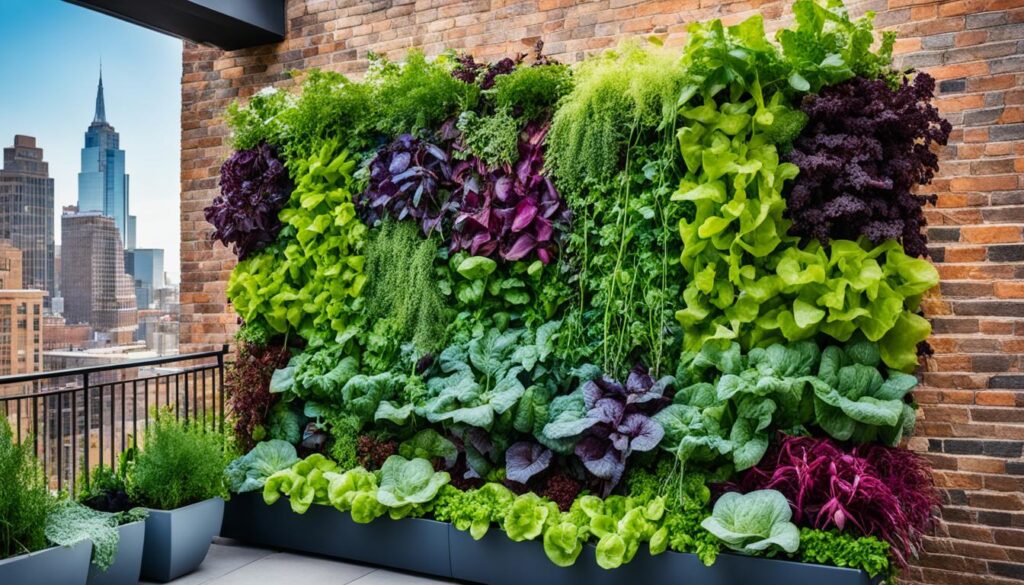
Squash and Gourds: Unique Additions to Your Vertical Garden
Vertical gardening is a great way to grow squash and gourds. These vegetables can do well in a vertical garden with the right support. Choose the right types and provide the right support to add squash and gourds to your garden.
Tips for Growing Squash and Gourds Vertically
For growing squash and gourds vertically, pick compact or bush-type varieties. Acorn squash and summer zucchini are good choices because their vines don’t spread out much. They can easily climb trellises or cages.
Gourds are also great for vertical gardens. Their vines can climb and make your garden look beautiful. Make sure to use a strong trellis or cage that can hold the fruit’s weight.
- Sow squash seeds 3 feet apart, with three seeds per spot to ensure at least one germinates.
- Use trellises that are at least 5 feet tall to support the growing vines.
- Attach the vines to the trellis using flagging tape or other soft, flexible materials.
- Consider creating fruit hammocks out of nylon stockings to provide extra support for the squash and gourds as they develop.
By following these tips and using vertical space in your garden, you can get a lot of squash and gourds. This way, you make the most of your garden space.
“Vertical gardening opens up a whole new world of possibilities for growing a diverse range of vegetables, including the unique and flavorful squash and gourds.”
Herbs: A Flavorful Addition to Your Vertical Garden
Vertical gardening is a great way to grow many herbs. Herbs like basil, mint, and thyme do well in these gardens. They let you have fresh, tasty herbs easily.
For growing herbs vertically, they need at least 6 hours of sunlight a day. Also, vertical gardens dry out quickly. So, watering and fertilizing them regularly is key to keeping them healthy.
Some top herbs for vertical gardens are:
- Basil – A favorite in cooking that grows well in containers or hanging baskets.
- Mint – Grows fast and spreads, but needs its own tier in vertical gardens to not take over.
- Thyme – Tough, drought-resistant herb that fits many vertical garden setups.
- Parsley – Adds flavor to many dishes and can be grown vertically.
- Rosemary – Lasts all year and does well in vertical gardens.
Pick herbs you use a lot in cooking for your vertical garden. A good vertical garden means you always have fresh, tasty herbs ready.
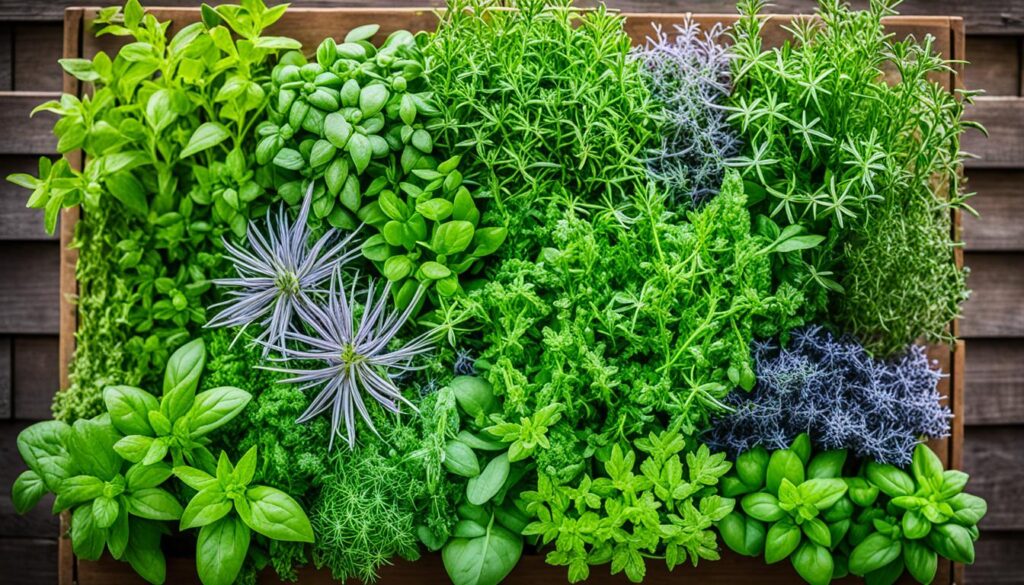
Trellis and Support Options for Vertical Gardens
Choosing the right trellis or support is key for vertical gardening. These structures help your climbing plants grow and add beauty to your garden. You can pick from many vertical garden trellis options to match your garden’s style.
Wooden Trellises for a Rustic Look
Wooden trellises are great for those who want a wooden trellises for vertical gardens look. Made from cedar or pressure-treated pine, they last long and look natural. These trellises fit well in any outdoor area, adding warmth and charm.
Metal Trellises for Durability and Style
For a metal trellises for vertical gardens option, metal trellises are a smart pick. They’re strong against the weather and support your plants well. You can find metal trellises in many styles, from simple to fancy. They’re perfect for small spaces, fitting on walls or fences.
| Trellis Type | Advantages | Disadvantages |
|---|---|---|
| Wooden Trellises |
|
|
| Metal Trellises |
|
|
Choosing between wooden or metal trellises depends on your style and garden needs. A good trellis supports your plants and adds beauty and function to your garden. For more tips on vertical gardening on a budget, check out this article.
“Choosing the right trellis not only supports your plants but also adds a decorative element to your garden.”
Conclusion
Vertical gardening is a great choice for those with little garden space or who want to add a unique look to their outdoor areas. You can grow a lot of fresh vegetables and make your garden look amazing. With the right crops and trellises, you can enjoy a variety of vegetables like tomatoes, cucumbers, squash, and gourds.
It’s perfect for saving space in cities or trying new gardening ways. Using smart watering systems and technology makes your garden sustainable and productive. This way, you can grow lots of fresh food even in small areas.
So, set up your trellises and start growing up. Get ready to impress your taste buds and garden with your vertical gardening. With some knowledge and creativity, you can turn your outdoor space into a lush garden. It will be full of tasty vegetables that do well in vertical gardens.
FAQ
What are the top vegetables that grow best in vertical gardens?
Great choices for vertical gardens include tomatoes, cucumbers, beans, peas, eggplants, squash, melons, pumpkins, gourds, and many herbs.
How does vertical gardening maximize growing space?
Vertical gardening lets you grow many crops in a small area by going up instead of out. It’s ideal for those with little garden space.
What are the benefits of vertical gardening?
Vertical gardens have many perks. They improve air flow, make harvesting easy, and look great. They also cut down on pests and diseases, and make gardening more convenient.
What types of trellises or support structures are best for vertical gardens?
You can use wooden, metal, or wall-mounted trellises for vertical gardens. Pick one based on the plant’s size and how you want your garden to look.
Can herbs be grown in a vertical garden?
Yes, many herbs do well in vertical gardens. You can grow basil, mint, and thyme in hanging pots or wall-mounted containers. This gives you fresh herbs right in your kitchen.

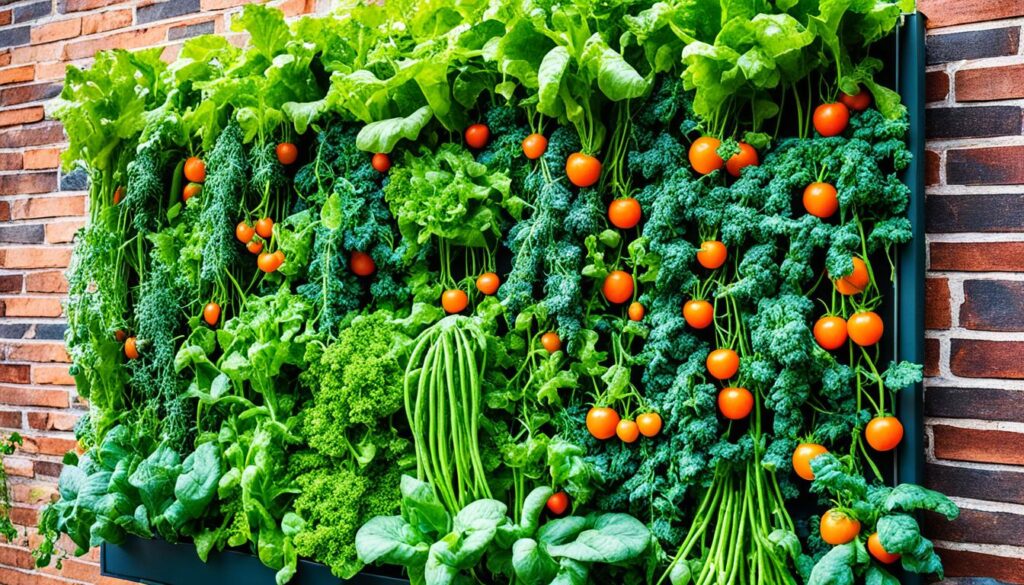
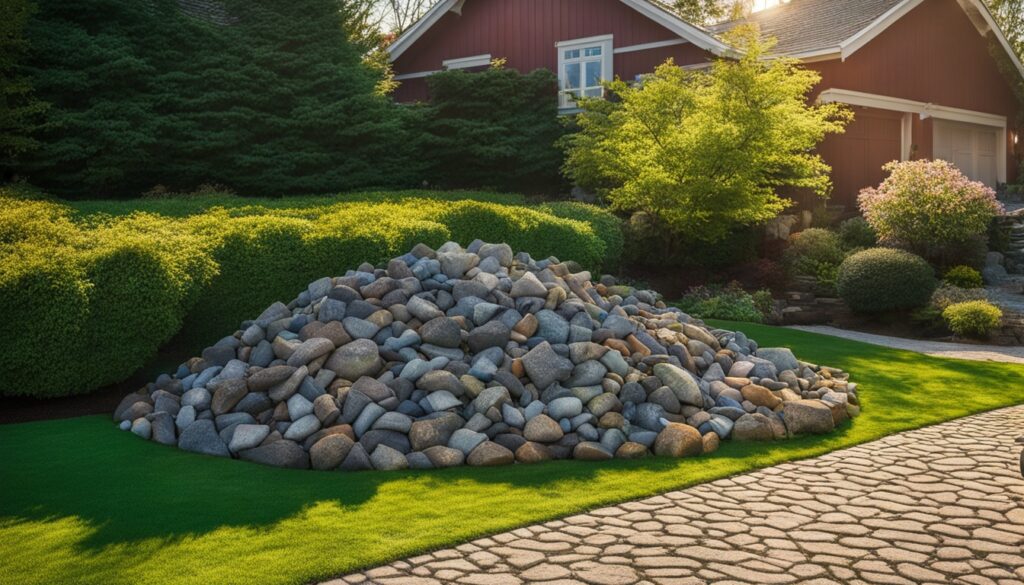
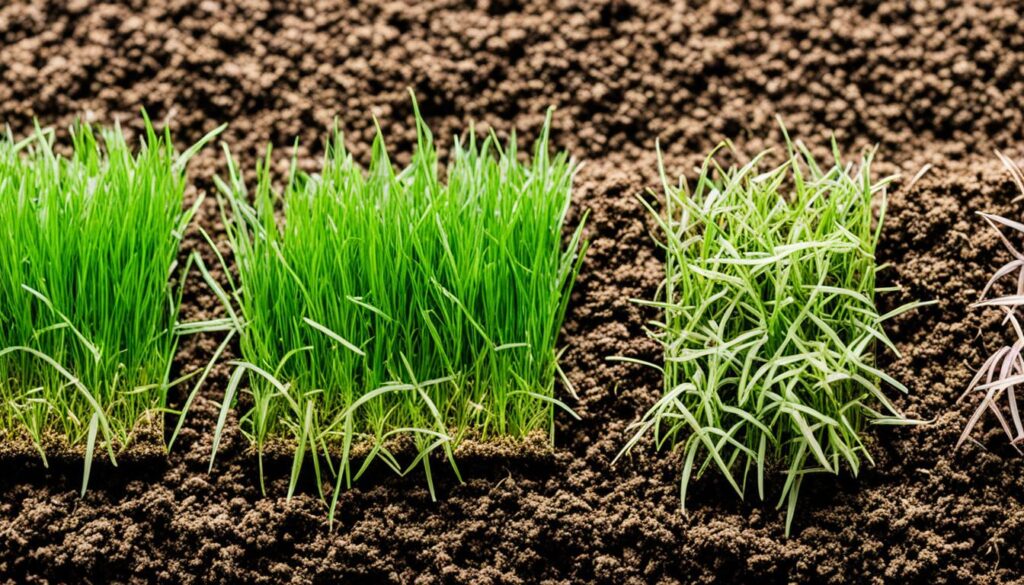
Thanks for sharing. I read many of your blog posts, cool, your blog is very good.
Thanks